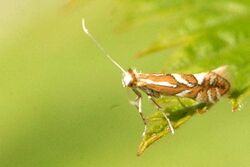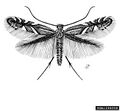Biology:Phyllonorycter oxyacanthae
| Phyllonorycter oxyacanthae | |
|---|---|

| |
| Scientific classification Error creating thumbnail: Unable to save thumbnail to destination
| |
| Domain: | Eukaryota |
| Kingdom: | Animalia |
| Phylum: | Arthropoda |
| Class: | Insecta |
| Order: | Lepidoptera |
| Family: | Gracillariidae |
| Genus: | Phyllonorycter |
| Species: | P. oxyacanthae
|
| Binomial name | |
| Phyllonorycter oxyacanthae (Frey, 1856)
| |
| Synonyms | |
| |
Phyllonorycter oxyacanthae is a moth of the family Gracillariidae found in all of Europe except the Balkan Peninsula. It was described by the German-born Swiss entomologist, Heinrich Frey in 1856. The larvae are known as leaf miners, living inside the leaves of their food plants.
Description
The wingspan is 6–8 mm. The moth is bivoltine, i.e. two generations in May and August.[1] The posterior tarsi with dark fuscous spots. Forewings are golden-brown to dark brown; a white median streak from base to near middle, dark margined above; dorsum narrowly white towards base; four costal and three dorsal white wedge-shaped spots, anteriorly blackish-margined, first costal small, first dorsal long, sometimes interrupted; a blackish apical spot. Hindwings are dark grey.[2]
- Similar species
Phyllonorycter sorbi and Phyllonorycter mespilella are close relatives and require genitalic examination to tell apart, alternatively collect the pupa from the food plants.[3]
- Ovum
Eggs are laid on the underside of a leaf.[4]
- Larvae
Larvae can be found in two generations; July and September to October and are greenish-yellow with a pale brown head. The mine is on the underside of a leaf, usually near an edge or lobe. There are many creases in the epidermis, which strongly contracts, causing the leaf-edge or lobe to fold over. The epidermis remains green, unlike the mines of Parornix anglicella which is smaller and the epidermis is brown.[3] Larvae have been found feeding on Crataegomespilus arnieresi, fireberry hawthorn (Crataegus chrysocarpa), hawthorn (Crataegus monogyna), small-flowered black hawthorn (Crataegus pentagyna), Crataegus rhipidophylla river hawthorn (Crataegus rivularis), quince (Cydonia oblonga), medlar (Mespilus germanica), scarlet firethorn (Pyracantha coccinea), common pear (Pyrus communis), rowan (Sorbus aucuparia) and Sorbus torminalis.[5]
- Pupa
Pupae are found in July and from October to May. The winter generation is in a flimsy golden-brown cocoon, while the summer generation is almost without a cocoon and the frass is behind a silken pad at the end of the lobe.[4]
References
- ↑ Kimber, Ian. "15.043 BF323 Phyllonorycter oxyacanthae". https://ukmoths.org.uk/species/phyllonorycter-oxyacanthae/.
- ↑ Meyrick, E., 1895 A Handbook of British Lepidoptera MacMillan, London pdf
 This article incorporates text from this source, which is in the public domain. Keys and description
This article incorporates text from this source, which is in the public domain. Keys and description
- ↑ 3.0 3.1 Smart, Ben (2017). Micro-moth Field Tips. Rishton: Lancashire & Cheshire Fauna Society. p. 207. ISBN 978-1-9997312-0-5.
- ↑ 4.0 4.1 Emmet, A M; Watkinson, I A; Wilson, M R (1985). Gracillaridae. In Moths and Butterflies of Great Britain and Ireland. Volume 2. Colchester: Harley Books. p. 314–5. ISBN 0-946589-19-4.
- ↑ Ellis, W N. "Phyllonorycter oxyacanthae (Frey, 1856) common thorn midget". https://bladmineerders.nl/parasites/animalia/arthropoda/insecta/lepidoptera/ditrysia/gracillarioidea/gracillariidae/lithocolletinae/phyllonorycter/phyllonorycter-oxyacanthae/.
Wikidata ☰ Q7189184 entry
 |




